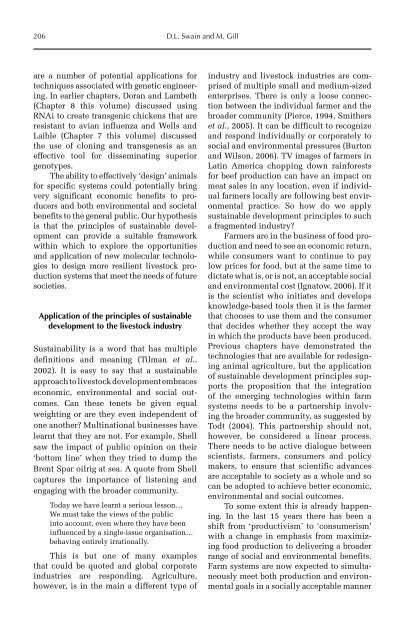Redesigning Animal Agriculture
Redesigning Animal Agriculture
Redesigning Animal Agriculture
You also want an ePaper? Increase the reach of your titles
YUMPU automatically turns print PDFs into web optimized ePapers that Google loves.
206 D.L. Swain and M. Gill<br />
are a number of potential applications for<br />
techniques associated with genetic engineering.<br />
In earlier chapters, Doran and Lambeth<br />
(Chapter 8 this volume) discussed using<br />
RNAi to create transgenic chickens that are<br />
resistant to avian influenza and Wells and<br />
Laible (Chapter 7 this volume) discussed<br />
the use of cloning and transgenesis as an<br />
effective tool for disseminating superior<br />
genotypes.<br />
The ability to effectively ‘design’ animals<br />
for specific systems could potentially bring<br />
very significant economic benefits to producers<br />
and both environmental and societal<br />
benefits to the general public. Our hypothesis<br />
is that the principles of sustainable development<br />
can provide a suitable framework<br />
within which to explore the opportunities<br />
and application of new molecular technologies<br />
to design more resilient livestock production<br />
systems that meet the needs of future<br />
societies.<br />
Application of the principles of sustainable<br />
development to the livestock industry<br />
Sustainability is a word that has multiple<br />
definitions and meaning (Tilman et al.,<br />
2002). It is easy to say that a sustainable<br />
approach to livestock development embraces<br />
economic, environmental and social outcomes.<br />
Can these tenets be given equal<br />
weighting or are they even independent of<br />
one another? Multinational businesses have<br />
learnt that they are not. For example, Shell<br />
saw the impact of public opinion on their<br />
‘bottom line’ when they tried to dump the<br />
Brent Spar oilrig at sea. A quote from Shell<br />
captures the importance of listening and<br />
engaging with the broader community.<br />
Today we have learnt a serious lesson…<br />
We must take the views of the public<br />
into account, even where they have been<br />
influenced by a single-issue organisation…<br />
behaving entirely irrationally.<br />
This is but one of many examples<br />
that could be quoted and global corporate<br />
industries are responding. <strong>Agriculture</strong>,<br />
however, is in the main a different type of<br />
industry and livestock industries are comprised<br />
of multiple small and medium-sized<br />
enterprises. There is only a loose connection<br />
between the individual farmer and the<br />
broader community (Pierce, 1994, Smithers<br />
et al., 2005). It can be difficult to recognize<br />
and respond individually or corporately to<br />
social and environmental pressures (Burton<br />
and Wilson, 2006). TV images of farmers in<br />
Latin America chopping down rainforests<br />
for beef production can have an impact on<br />
meat sales in any location, even if individual<br />
farmers locally are following best environmental<br />
practice. So how do we apply<br />
sustainable development principles to such<br />
a fragmented industry?<br />
Farmers are in the business of food production<br />
and need to see an economic return,<br />
while consumers want to continue to pay<br />
low prices for food, but at the same time to<br />
dictate what is, or is not, an acceptable social<br />
and environmental cost (Ignatow, 2006). If it<br />
is the scientist who initiates and develops<br />
knowledge-based tools then it is the farmer<br />
that chooses to use them and the consumer<br />
that decides whether they accept the way<br />
in which the products have been produced.<br />
Previous chapters have demonstrated the<br />
technologies that are available for redesigning<br />
animal agriculture, but the application<br />
of sustainable development principles supports<br />
the proposition that the integration<br />
of the emerging technologies within farm<br />
systems needs to be a partnership involving<br />
the broader community, as suggested by<br />
Todt (2004). This partnership should not,<br />
however, be considered a linear process.<br />
There needs to be active dialogue between<br />
scientists, farmers, consumers and policy<br />
makers, to ensure that scientific advances<br />
are acceptable to society as a whole and so<br />
can be adopted to achieve better economic,<br />
environmental and social outcomes.<br />
To some extent this is already happening.<br />
In the last 15 years there has been a<br />
shift from ‘productivism’ to ‘consumerism’<br />
with a change in emphasis from maximizing<br />
food production to delivering a broader<br />
range of social and environmental benefits.<br />
Farm systems are now expected to simultaneously<br />
meet both production and environmental<br />
goals in a socially acceptable manner










